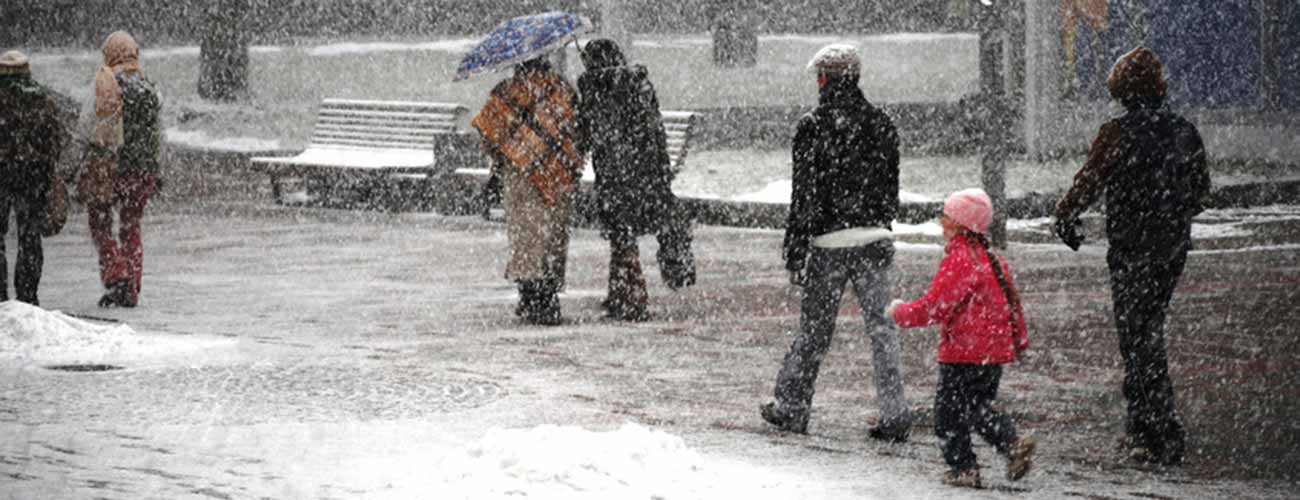Major. Colossal. Immobilizing. Paralyzing. Potentially historic. Scratch that. Historic.
These words should sound familiar to anyone keeping up with the weather. Last weekend, news outlets began warning of a snowstorm ready to smack the Northeast today. Much of the media coverage ramped up the hyperbole throughout the week, following a proud tradition of producing weather stories with greater emphasis on alarm than caution. This storm may well turn into a doozie, but no outcome justifies fear-mongering when the weather is just a forecast.
Now comes a renegade brand of meteorologists who are more careful in how they report on emerging storms. Their jobs are twofold: Inform people of the weather and quash any hype and misinformation that’s making the rounds–especially on social media. These folks publish detailed forecasts that don’t zoom in only on the worst-case scenario. Talk about a public service.
“I have to play defense as a meteorologist nowadays because of social media and digital media,” says Dan Zarrow, chief meteorologist for the radio company Townsquare New Jersey, which owns 10 stations in the state. “No weather forecast is complete without including some measure of the forecaster’s confidence or certainty.” He kicked off his coverage on Monday with an in-depth rundown of possible storm scenarios and what his audience should have done to prepare at that time (“probably nothing”). Zarrow was also strikingly honest about the limits of “the inexact science of meteorology” and his inability to predict anything comprehensive more than three days out. “And even then it can be a stretch,” he wrote.
He has yet to let up with his explanatory, conservative briefings.
Major storm with "potential" to bring historic amounts of snow expected to hit East Coast. https://t.co/tvOKAQkVKi pic.twitter.com/w0px3q6m1S
— ABC News (@ABC) January 21, 2016
Northeast braces for potential "big storm"; about 50M people could see 1-2 feet of snow https://t.co/iO93gjfXfO pic.twitter.com/nkAe9ovH89
— CBS News (@CBSNews) January 20, 2016
'The Mid-Atlantic is going to get walloped' by a massive snowstorm https://t.co/8VJHwBZzxU pic.twitter.com/t5zadIHDEo
— NBC News (@NBCNews) January 21, 2016
The Garden State also delivered its readers cautious early-bird takes from NJ.com and NorthJersey.com on the elements that would produce a big storm and the level of uncertainty. (Disclosure: I interned for NorthJersey.com last summer.) This kind of level-headed reporting is starting to take hold elsewhere. Tom Wood, weather columnist for the Philadelphia Inquirer, urged readers to stay cool instead of blasting rumors across social media. The New York Times and The Washington Post published moderate stories that placed emphasis on the questionable strength of the approaching storm.
Another cause for optimism? Meteorologists and weather reporters across the country are calling out social media for its hype and drama, as when an NBC affiliate in North Carolina told its audience that a popular Facebook photo was not a forecast, but a single unreliable model. James Spann, chief meteorologist for the ABC affiliate in Birmingham, Alabama, wrote a piece this month that slammed amateur “social media-rologists” for publishing wild, unlikely forecasts, presumably to gain clicks and followers. But sometimes it exposes fault lines. Sean Breslin, an associate editor for The Weather Channel, recently penned a story encouraging social media users to think before they share. Only a reader rightly pointed out that the news outlet’s app predicts snow accumulation totals further out than recommended in the story.
Meteorologists say the rapid-fire nature of social sharing, and the ability of anyone to post a mere guess, are driving the need to rein in the hype.
It isn’t only social media, though. The three major TV networks love few things more than a looming storm. None of the three major networks, ABC, NBC, or CBS, agreed to speak for this story.
The thing is, it’s hard to make a case that trumped-up coverage is the only way to gain an audience. Media outlets can easily lace their forecasts with qualifying language that highlights the range of possibilities, remaining technically accurate. But phrases like “up to three feet” only describe one potential outcome and ignore more realistic results. This kind of reporting serves to boost ratings and traffic–a phenomenon known as “wet bias”–more than benefit the public.
“If every storm is a monster storm with 80 million in the path, what happens when you really do have a monster storm with 80 million in the path?” Spann asks. “The day that you need to reach people, nobody’s going to listen to you because of the constant hype machine.”
That kind of hype was in full view last January when a historic storm was supposed to hit New York City. But forecasts predicting two feet of snow gave way to six inches. The botched call led to public fury over the blaring forecasts and pre-storm coverage.
There is an argument that warning of the danger, however uncertain, is itself a public service because it draws attention to possible snowstorms, tornadoes, and hurricanes that can cause severe damage if people are caught totally off-guard. The sweet spot lies in forecasting and reporting that presents all likely scenarios.
News consumers don’t allow sportswriters and political journalists to get away with publishing predictions that lack a thorough explanation. The science of meteorology warrants the same kind of rigor.
Jack Murtha is a CJR Delacorte Fellow. Follow him on Twitter at @JackMurtha

